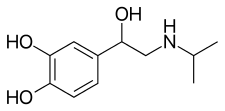Isoprenaline
Isoprenaline, or isoproterenol, is a medication used for the treatment of bradycardia (slow heart rate), heart block, and rarely for asthma. It is a non-selective β adrenoreceptor agonist that is the isopropylamine analog of epinephrine (adrenaline).[2]
 | |
| Clinical data | |
|---|---|
| Trade names | Many[1] |
| Other names | Isoproterenol (USAN US) |
| MedlinePlus | a601236 |
| Pregnancy category | |
| Routes of administration | Inhalation (80–120 μg), intravenous injection (IV) |
| ATC code | |
| Legal status | |
| Legal status |
|
| Pharmacokinetic data | |
| Elimination half-life | ~2 minutes |
| Identifiers | |
IUPAC name
| |
| CAS Number | |
| PubChem CID | |
| IUPHAR/BPS | |
| DrugBank | |
| ChemSpider | |
| UNII | |
| KEGG | |
| ChEMBL | |
| CompTox Dashboard (EPA) | |
| ECHA InfoCard | 100.028.807 |
| Chemical and physical data | |
| Formula | C11H17NO3 |
| Molar mass | 211.258 g/mol g·mol−1 |
| 3D model (JSmol) | |
SMILES
| |
InChI
| |
| (verify) | |
Medical uses
It is used to treat heart block and episodes of Adams-Stokes syndrome that are not caused by ventricular tachycardia or fibrillation, in emergencies for cardiac arrest until electric shock can be administered, for bronchospasm occurring during anesthesia, and as an adjunct in the treatment of hypovolemic shock, septic shock, low cardiac output (hypoperfusion) states, congestive heart failure, and cardiogenic shock.[2]
Historically, it was used to treat asthma via metered aerosol or nebulizing devices; it was also available in sublingual, oral, intravenous, and intramuscular formulations.[3] The U.S. National Asthma Education and Prevention Program Expert Panel recommends against its use as a nebulizer for acute bronchoconstriction.[4]
Contraindications
It should not be used in people with tachyarrhythmias, tachycardia or heart block caused by digitalis poisoning, ventricular arrhythmias which require inotropic therapy, or with angina.[2]
Adverse effects
Adverse effects of isoprenaline include nervousness, headache, dizziness, nausea, visual blurring, tachycardia, palpitations, angina, Adams-Stokes attacks, pulmonary edema, hypertension, hypotension, ventricular arrhythmias, tachyarrhythmias, difficulty breathing, sweating, mild tremors, weakness, flushing, and pallor.[2]
Pharmacology
The adverse effects of isoprenaline are also related to the drug's cardiovascular effects. Isoprenaline can produce tachycardia (an elevated heart rate), which predisposes people who take it to cardiac arrhythmias.[3]
Pharmacodynamics
Isoprenaline is a β1 and β2 adrenoreceptor agonist and has almost no activity against alpha adrenergic receptors.[3] Its agonist effects at TAAR1 provide it with a pharmacodynamic effects that resemble those of the endogenous trace amines, like tyramine.[5]
Isoprenaline's effects on the cardiovascular system (non-selective) relate to its actions on cardiac β1 receptors and β2 receptors on smooth muscle within the tunica media of arterioles. Isoprenaline has positive inotropic and chronotropic effects on the heart. β2 adrenoceptor stimulation in arteriolar smooth muscle induces vasodilation. Its inotropic and chronotropic effects elevate systolic blood pressure, while its vasodilatory effects tend to lower diastolic blood pressure. The overall effect is to decrease mean arterial pressure due to the β2 receptors' vasodilation.[6]
The isopropylamine group in isoprenaline makes it selective for β receptors. The free catechol hydroxyl groups keep it susceptible to enzymatic metabolism.[7]
Pharmacokinetics
The plasma half-life for isoprenaline is approximately two minutes.
Chemistry
It is structurally related to epinephrine.[2]
History
It was first approved in the US in 1947.[3] Between 1963 and 1968 in England, Wales, Scotland, Ireland, Australia, and New Zealand there was an increase in deaths among people using isoprenaline to treat asthma. This was attributed to overdose: the inhalers produced in that area were dispensing five times the dosage dispensed by inhalers produced in the US and Canada, where the deaths were not observed.[8][9]
Society and culture
Brands
As of June 2017, isoprenaline was marketed under many brand names worldwide and as two different salts: Aleudrina, Asthpul, Iludrin, Isomenyl, Isoprenalin, Isoprenalina, Isoprenalina, Isoprenalina, Isoprenaline, Isoprenaline, Isoprénaline, Isoprénaline, Isoprenaline hydrochloride, Isoprenaline sulfate, Isoprenalinesulfaat, Isoprenalinsulfat, Isoprenalinum, Isopropydine, Isopropylnoradrenaline, Isoproterenol, Isoproterenol, Isoproterenol, Isoproterenol hydrochloride, Isoproterenol sulfate, Isuprel, Isuprel, Neo-Epinine, Neodrenal, Proternol, Saventrine, and Win 5162.[1] It is also marketed as a combination drug with cromoglicic acid as Frenal Compositum, in combination with pronase as Isopal P, and in combination with atropine as Stmerin D.[1]
References
- "Isoprenaline international brands". Drugs.com. Retrieved 21 June 2017.
- "Label: Isoproterenol hydrochloride injection, solution". NIH DailyMed. September 10, 2013. Retrieved 21 June 2017.
- Mozayani, Ashraf; Raymon, Lionel (2003). Handbook of Drug Interactions: A Clinical and Forensic Guide. Springer Science & Business Media. pp. 541–542. ISBN 9781592596546.
- National Asthma Education and Prevention Program Expert Panel (August 28, 2007). "Expert Panel Report 3: Guidelines for the Diagnosis and Management of Asthma" (PDF). NIH National Heart, Lung, and Blood Institute.
- Kleinau G, Pratzka J, Nürnberg D, Grüters A, Führer-Sakel D, Krude H, Köhrle J, Schöneberg T, Biebermann H (October 2011). "Differential modulation of Beta-adrenergic receptor signaling by trace amine-associated receptor 1 agonists". PLoS ONE. 6 (10): e27073. doi:10.1371/journal.pone.0027073. PMC 3205048. PMID 22073124.
"Table 1: EC50 values of different agonists at hTAAR1, hADRB1 and hADRB2." - Korbut, Ryszard (2017). Farmakologia (in Polish). Wydawnictwo Lekarskie PZWL. p. 36. ISBN 9788320053685.
- Mehta, Akul (January 27, 2011). "Notes - Medicinal Chemistry of the Peripheral Nervous System - Adrenergics and Cholinergic". Pharmaxchange. Retrieved 21 June 2017.
- Pierce, Neil; Hensley, Michael J. (1998). "Epidemiologic Studies of Beta Agonists and Asthma Deaths" (PDF). Epidemiologic Studies. 20 (2). PMID 9919437.
- Jalba, MS (2008). "Three generations of ongoing controversies concerning the use of short acting beta-agonist therapy in asthma: a review". The Journal of Asthma. 45 (1): 9–18. doi:10.1080/02770900701495512. PMID 18259990.